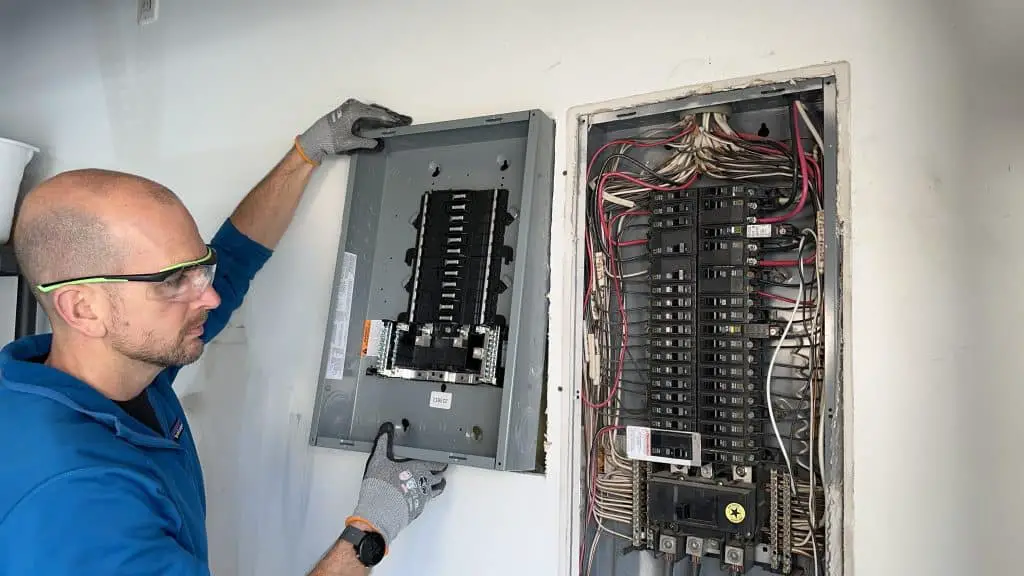I have completed multiple subpanel installations and documented them on our YouTube channel to help homeowners safely take on this type of project while saving money but one common question I get asked is “How much would a subpanel installation cost if I hired an electrician?”
There is not one answer to this question. The cost of this type of job will depend on a variety of factors such as your location, the age of your home, your current electrical configuration, and the proximity of the new subpanel to the main panel.
SAFETY NOTE: Do keep in mind that if you take on a project like this you’ll need to be knowledgeable in electrical code and have a solid understanding of local regulations.
The project documented in the above video included 75 feet of trench running across a concrete driveway from the home to the detached garage.
This project is going to be on the higher-cost end for subpanels because of all the labor involved in digging the trench:
- DIY Installation = $1,100 ($800 materials and $300 rental equipment)
- Professional Installation = $4,000 – $6,000
Cost of Installing a Subpanel Next to the Main Electrical Panel
Let’s dive a bit deeper and see how the cost of installing a subpanel can vary depending on a few factors. Let’s assume you’re installing a subpanel next to your main panel because you need additional capacity.

To follow are cost-estimate tables that break down the costs into three areas: materials, labor, and total cost. Obviously, DIY projects would just involve materials as your time is “free.” For professional installations, we’ll need to consider both materials and labor.
The tables break out the cost estimates into three ranges according to the age of your home and how expensive the labor market is where you reside. For instance, doing this installation on a 1920s-built home in Chicago (high-price market) could cost 2X – 3X as much as doing the same type of job on a 1990s-built home in Peoria (low-price market).
Cost of Materials
You’ll notice that the cost of materials goes up as the age of the home goes up. This is because the new panel and wiring might not be compatible with the existing wiring in your home, which will necessitate some additional materials for the job. If your home has a fuse panel or knob-and-tube wiring, the material costs could be substantially higher.
| Built Before 1950 | Built 1950 – 1980 | Built After 1980 | |
| Low-Price Markets | $450 | $400 | $350 |
| Mid-Price Markets | $450 | $400 | $350 |
| High-Price Markets | $450 | $400 | $350 |
Labor Costs
Labor rates are not an exact science but often will go up as you move from rural communities to urban communities. Some cities such as Chicago have additional codes for residential construction that can drive up the cost of both materials and labor.
Hourly rates used are:
- $100/hour for low-price markets
- $150/hour for mid-price markets
- $200/hour for high-price markets
In a situation where the panel is going right next to your existing panel, the installation will take 8 hours of labor to complete in modern homes (built after 1980).
The hours of labor needed will go up as the age of your home goes up. Compared to a home built after 1980, a subpanel installation in a home built between 1950 and 1980 will take 25% more time. For a home built before 1950, it will be 50% higher.
| Built Before 1950 | Built 1950-1980 | Built After 1980 | |
| Low-Price Markets | $1,200 | $1,000 | $800 |
| Mid-Price Markets | $1,800 | $1,500 | $1,200 |
| High-Price Markets | $2,400 | $2,000 | $1,600 |
Total Cost of a Professional Subpanel Installation
| Built Before 1950 | Built 1950-1980 | Built After 1980 | |
| Low-Price Markets | $1,650 | $1,400 | $1,150 |
| Mid-Price Markets | $2,250 | $1,900 | $1,550 |
| High-Price Markets | $2,850 | $2,400 | $1,950 |




